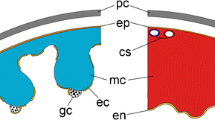Summary
The preparation of isolated peptidergic nerve terminals from the sinus gland (a neurohemal organ) of the crab (Cardisoma carnifex) is described. In this species the nerve endings can have diameters up to 30 μm. They release neurosecretory material as judged by the decrease in the volumetric density of granules upon depolarization with potassium. Similar results were obtained after permeabilization of the nerve terminals with digitonin, but only in the presence of micromolar concentrations of calcium. This preparation should prove useful in correlating electrical events with other cellular processes involved in stimulus-secretion coupling.
Similar content being viewed by others
References
Aoto T, Hisano S (1985) Ultrastructural evidence for the existence of the distal retinal pigment light-adapting hormone in the sinus gland of the prawn Palaemon paucidens. Gen Comp Endocrinol 60:468–474
Bicknell J, Cazalis M, Dayanithi G, Nordmann JJ (1985) Calcium-dependence of hormone release from isolated neurohypophysial nerve endings (neurosecretosomes) of the rat. J Physiol 369:166P
Brooks JC, Treml S (1983) Catecholamine secretion by chemically skinned cultured chromaffin cells. J Neurochem 40:468–473
Cooke IM (1985) Electrophysiological characterization of peptidergic neurosecretory terminals. J Exp Biol 118:1–36
Cooke IM, Haylett BA (1984) Ionic dependence of secretory and electrical activity evoked by elevated K+ in a crab peptidergic neurosecretory system. J Exp Biol 113:289–321
Cooke IM, Stuenkel E (1985) Electrophysiology of invertebrate neurosecretory cells. In: Poisner AM, Trifaro J (eds) Electrophysiology of the secretory cell. Vol. 2. Elsevier, Amsterdam
Douglas WW, Rubin P (1963) The effects of alkaline earth and other divalent cations on adrenal medullary sections. J Physiol 167:288–310
Douglas WW, Poisner AM (1964) Stimulus-secretion coupling in a neurosecretory organ and the role of calcium in the release of vasopressin from the neurohypophysis. J Physiol 172:1–18
Dunn LA, Holz RW (1983) Catecholamine secretion from digitonin-treated adrenal medullary chromaffin cells. J Biol Chem 258:4989–4993
Elias PM, Goerke J, Friend DS, Brown BE (1978) Freeze-fracture identification of sterol-digitonin complexes in cell and liposome membranes. J Cell Biol 78:577–596
Jaros PP, Dircksen H, Keller R (1985) Occurrence of immunoreactive enkephalins in a neurohemal organ and other nervous structures in the eyestalk of the shore crab, Carcinus maenas L.-Crustacea, Decapoda. Cell Tissue Res 241:111–117
Katz B, Miledi R (1967) A study of synaptic transmission in the absence of nerve impulses. J Physiol 192:407–436
Knight DE, Baker PF (1982) Calcium-dependence of catecholamine release from bovine adrenal medullary cells after exposure to intense electric fields. J Membr Biol 68:107–140
Lemos R, Nordmann JJ, Cooke IM, Stuenkel EL (1986) Single channels and ionic currents in peptidergic nerve terminals. Nature 319:410–412
Lescure H, Nordmann JJ (1980) Neurosecretory granule release and endocytosis during prolonged stimulation of the rat neurohypophysis in vitro. Neuroscience 5:651–659
Llinas R, Steinberg IZ, Walton K (1981) Relationship between presynaptic calcium current and postsynaptic potential in squid giant synapse. Biophys J 33:323–352
Martell AE, Smith RE (1974) Critical Stability Constants. Plenum Press, New York
Morris JF, Nordmann JJ (1980) Membrane recapture after hormone release from nerve endings in the neural lobe of the rat pituitary gland. Neuroscience 5:639–649
Newcomb RW (1983) Peptides in the sinus gland of Cardisoma carnifex: isolation and amino acid analysis. J Comp Physiol B 153:207–221
Newcomb R, Stuenkel E, Cooke I (1985) Characterization, biosynthesis, and release of neuropeptides from the X-organ — sinus gland system of the crab, Cardisoma carnifex. Am Zool 25:157–171
Nordmann JJ (1983) Stimulus-secretion coupling. Prog Brain Res 60:281–303
Nordmann JJ, Morris JF (1980) Depletion of neurosecretory granules and membrane retrieval in the sinus gland of the crab. Cell Tissue Res 205:31–42
Nordmann JJ, Louis F, Morris SJ (1979) Purification of two structural and morphologically distinct populations of rat neurohypophysial secretory granules. Neuroscience 4:1367–1379
Stewart WW (1981) Lucifer dyes-Highly fluorescent dyes for biological tracing. Nature 292:17–21
Strolenberg GEC, Van Herp F (1977) Mise en évidence du phénomène d'exocytose dans la glande du sinus d'Astacus leptodactylus -Nordmannsous l'influence d'injections de sérotonine. CR Acad Sci Paris, série D 284:57–58
Stuenkel EL (1983) Biosynthesis and axonal transport of proteins and identified peptide hormones in the X-organ sinus gland neurosecretory system. J Comp Physiol B 207:191–205
Stuenkel EL (1985) Simultaneous monitoring of electrical and secretory activity in peptidergic neurosecretory terminals of the crab. J Physiol 359:163–187
Stuenkel EL, Newcomb R, Nagano M, Cooke I (1985) Correlation of electrical, secretory, and biosynthetic responses of crab peptidergic neurosecretory cells. In: H Kobayashi, NA Bern, A Urano (eds) Neurosecretion and the biology of neuropeptides. Japan Sci Soc Press, Tokyo, pp 70–79
Weatherby TM (1981) Ultrastructural study of the sinus gland of the crab, Cardisoma carnifex. Cell Tissue Res 220:253–312
Weatherby TM, Haylett BA (1985) Ultrastructural changes associated with K+-evoked peptide secretion from a neurohemal organ of the crab, Cardisoma carnifex. Cell Tissue Res 242:67–73
Weibel ER (1969) Stereological principles for morphometry in electron microscopic cytology. Int Rev Cytol 26:235–302
Wilson SP, Kirshner N (1983) Calcium-evoked secretion from digitonin-permeabilized adrenal medullary chromaffin cells. J Biol Chem 258:4994–5000
Author information
Authors and Affiliations
Rights and permissions
About this article
Cite this article
Nordmann, J.J., Weatherby, T.M. & Haylett, B.A. Ultrastructural changes in isolated peptidergic nerve terminals induced by digitonin permeabilization and K+ stimulation in the sinus gland of the crab, Cardisoma carnifex . Cell Tissue Res. 246, 365–371 (1986). https://doi.org/10.1007/BF00215899
Accepted:
Issue Date:
DOI: https://doi.org/10.1007/BF00215899




